Fantasy comedy or comic fantasy is a subgenre of fantasy that is primarily humorous in intent and tone. Typically set in imaginary worlds, fantasy comedy often involves puns on, and parodies of, other works of fantasy.

Lyon Sprague de Camp was an American author of science fiction, fantasy and non-fiction literature. In a career spanning 60 years, he wrote over 100 books, including novels and works of non-fiction, including biographies of other fantasy authors. He was a major figure in science fiction in the 1930s and 1940s.
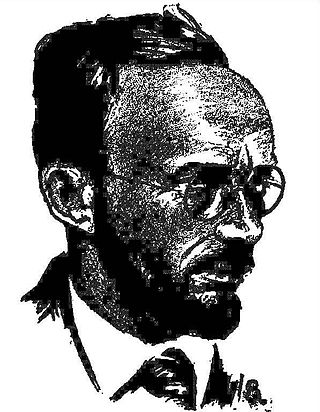
Murray Fletcher Pratt was an American writer of history, science fiction, and fantasy. He is best known for his works on naval history and the American Civil War and for fiction written with L. Sprague de Camp.

Harold Shea is the protagonist of five science fantasy stories by the collaborative team of L. Sprague de Camp and Fletcher Pratt, as well as later stories by de Camp alone, Christopher Stasheff, Holly Lisle, John Maddox Roberts, Roland J. Green, Frieda A. Murray, Tom Wham, and Lawrence Watt-Evans. De Camp and Stasheff collectively oversaw the continuations. The series is also known as the "Enchanter" series, the "Incomplete Enchanter" series or the "Compleat Enchanter" series.

The Castle of Iron is the title of a fantasy novella by American authors L. Sprague de Camp and Fletcher Pratt, and of the novel into which it was later expanded by the same authors. It was the third story in their Harold Shea series. As a 35,000-word novella it was first published in the fantasy magazine Unknown for April, 1941. The revised and expanded novel version was first published in hardcover by Gnome Press in 1950, and in paperback by Pyramid Books in 1962. The book has been reprinted by a number of other publishers since its first appearance. An e-book edition was published by Gollancz's SF Gateway imprint on September 29, 2011 as part of a general release of de Camp's works in electronic form. The novel has been combined with other books in the series in the omnibus editions The Compleat Enchanter (1975), The Complete Compleat Enchanter (1989) and The Mathematics of Magic: The Enchanter Stories of L. Sprague de Camp and Fletcher Pratt (2007). It has also been translated into Italian.

John Drury Clark, Ph.D. was an American rocket fuel developer, chemist, and science fiction writer. He was instrumental in the revival of interest in Robert E. Howard's Conan stories and influenced the writing careers of L. Sprague de Camp, Fletcher Pratt, and other authors.
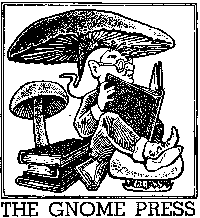
Gnome Press was an American small-press publishing company primarily known for publishing many science fiction classics. Gnome was one of the most eminent of the fan publishers of SF, producing 86 titles in its lifespan — many considered classic works of SF and Fantasy today. Gnome was important in the transitional period between Genre SF as a magazine phenomenon and its arrival in mass-market book publishing, but proved too underfunded to make the leap from fan-based publishing to the professional level. The company existed for just over a decade, ultimately failing due to inability to compete with major publishers who also started to publish science fiction. In its heyday, Gnome published many of the major SF authors, and in some cases, as with Robert E. Howard's Conan series and Isaac Asimov's Foundation series, was responsible for the manner in which their stories were collected into book form.
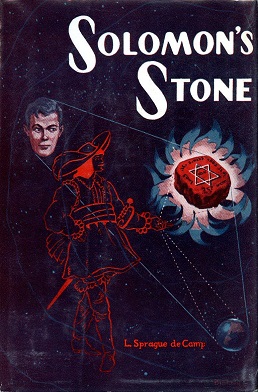
Solomon's Stone is a fantasy novel by American writer L. Sprague de Camp. It was first published in the magazine Unknown Worlds in June 1942. It was reprinted in the Summer 1949 issue of the British edition of Unknown, and then published in book form by Avalon Books in 1957.

The Dragon of the Ishtar Gate is a historical novel by American writer L. Sprague de Camp, first published in hardcover by Doubleday in 1961, and in paperback by Lancer Books in 1968. The first trade paperback edition was issued by The Donning Company in 1982. The book was reissued with a new introduction by Harry Turtledove as a trade paperback and ebook by Phoenix Pick in September 2013. It is the third of de Camp's historical novels in order of writing, and earliest chronologically. It is set in 466-465 BCE, the last years of the reign of King Xerxes I of Persia.

The Undesired Princess is a 51,000 word fantasy novella by American writer L. Sprague de Camp. It was first published in the fantasy magazine Unknown Worlds for February 1942. It was published in book form by Fantasy Publishing Company, Inc. in 1951. The book version also includes the 10,000 word fantasy short story "Mr. Arson", first published in Unknown for December 1941. The book was bound together with Stanley G. Weinbaum's The Dark Other in the omnibus collection Fantasy Twin by the same publisher in 1953. The title story was also published in paperback by Baen Books in 1990 together with David Drake's story The Enchanted Bunny, under the combined title The Undesired Princess & the Enchanted Bunny.

Land of Unreason is a fantasy novel by American writers Fletcher Pratt and L. Sprague de Camp. It was first published in the fantasy magazine Unknown Worlds for October, 1941 as "The Land of Unreason". Revised and expanded, it was first published in book form by Henry Holt and Company in 1942. It has been reprinted numerous times since by various publishers, including by Ballantine Books in January 1970 as the tenth volume of the Ballantine Adult Fantasy series. An E-book edition was published by Gollancz's SF Gateway imprint on September 29, 2011 as part of a general release of de Camp's works in electronic form.

The Glory That Was is a science fiction novel by American writer L. Sprague de Camp. It was first published in the science fiction magazine Startling Stories for April, 1952, and subsequently published in book form in hardcover by Avalon Books in 1960 and in paperback by Paperback Library in March 1971. It has since been reprinted in paperback by Ace Books in July 1979 and Baen Books in April 1992, and in trade paperback by Phoenix Pick in September 2014. An E-book edition was published by Gollancz's SF Gateway imprint on September 29, 2011 as part of a general release of de Camp's works in electronic form; a second e-book edition was issued by Phoenix Pick in September 2014. The book has also been translated into Italian, German and Greek.

The Return of Conan is a 1957 fantasy novel written by Björn Nyberg and L. Sprague de Camp, featuring Robert E. Howard's sword and sorcery hero Conan the Barbarian. It was first published in hardcover by Gnome Press and in paperback by Lancer Books as part of the collection Conan the Avenger in 1968; in this form it has been reprinted a number of times since by various publishers. It has also been translated into Japanese, German and Spanish.

Conan the Swordsman is a collection of seven fantasy short stories and associated pieces by writers L. Sprague de Camp, Lin Carter and Björn Nyberg featuring Robert E. Howard's sword and sorcery hero Conan the Barbarian. It was first published in paperback by Bantam Books in August 1978, and reprinted in 1981. Later paperback editions were issued by Ace Books. The first hardcover edition was published by Tor Books in December 2002. The first British edition was issued by Sphere Books in 1978. The book has also been translated into Italian and French. It was later gathered together with Conan the Liberator and Conan and the Spider God into the omnibus collection Sagas of Conan.
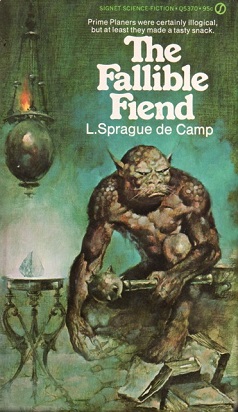
The Fallible Fiend is a fantasy novel by American writer L. Sprague de Camp, the third book of his Novarian series. It was first published as a two-part serial in the magazine Fantastic for December 1972 and February 1973, and subsequently expanded and revised for book publication. The novel was first published in book form as a paperback by Signet Books in 1973; it was later reprinted by Remploy (1974), Sphere (1978), Del Rey/Ballantine (1981), Baen (1992) and the Thorndike Press (2002). The Remploy edition was both the first British and first hardcover edition. An e-book edition was published by Gollancz's SF Gateway imprint on September 29, 2011 as part of a general release of de Camp's works in electronic form. It has also been translated into German and Italian.

The Viagens Interplanetarias series is a sequence of science fiction stories by L. Sprague de Camp, begun in the late 1940s and written under the influence of contemporary space opera and sword and planet stories, particularly Edgar Rice Burroughs's Martian novels. Set in the future in the 21st and 22nd centuries, the series is named for the quasi-public Terran agency portrayed as monopolizing interstellar travel, the Brazilian-dominated Viagens Interplanetarias. It is also known as the Krishna series, as the majority of the stories belong to a sequence set on a fictional planet of that name. While de Camp started out as a science fiction writer and his early reputation was based on his short stories in the genre, the Viagens tales represent his only extended science fiction series.
Bibliography of science fiction, fantasy, historical fiction and nonfiction writer L. Sprague de Camp:
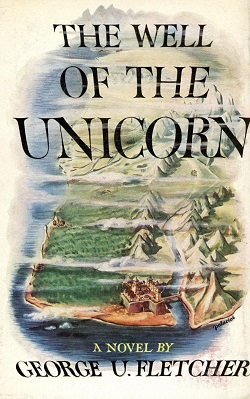
The Well of the Unicorn is a fantasy novel by the American writer Fletcher Pratt. It was first published in 1948, under the pseudonym George U. Fletcher, in hardcover by William Sloane Associates. All later editions have appeared under the author's actual name with the exception of the facsimile reprint issued by Garland Publishing in 1975 for its Garland Library of Science Fiction series. The novel was first issued in paperback in 1967 by Lancer Books, which reprinted it in 1968; subsequent paperback editions were issued by Ballantine Books. The first Ballantine edition was in May 1976, and was reprinted three times, in 1979, 1980, and 1995. The most recent edition was a trade paperback in the Fantasy Masterworks series from Gollancz in 2001. The book has also been translated into German, and into Russian in 1992.

The Incomplete Enchanter is a collection of two fantasy novellas by American writers L. Sprague de Camp and Fletcher Pratt, the first volume in their Harold Shea series. The pieces were originally published in the magazine Unknown in the issues for May and August 1940. The collection was first published in hardcover by Henry Holt and Company in 1941 and in paperback by Pyramid Books in 1960.
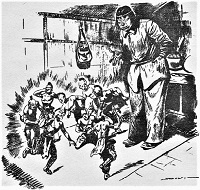
"The Reluctant Shaman" is a contemporary fantasy story by American writer L. Sprague de Camp. It was first published in the magazine Thrilling Wonder Stories for April 1947. It first appeared in book form in the collection The Reluctant Shaman and Other Fantastic Tales ; it later appeared in the magazine Science Fiction Yearbook no. 5 and the collection The Best of L. Sprague de Camp. The story has been translated into French and German.


















